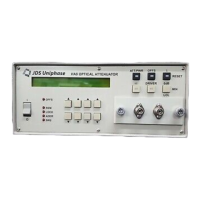Programming Guide – 49
• Boolean—0, 1, ON, OFF. Any other numeric value sent is rounded to the nearest integer.
If the resulting integer is anything but 0, it is interpreted as 1.
• Character—A character string that contains no more than 12 characters. Each character in
the string must be either an uppercase or a lowercase letter, a digit (0 to 9), or an
underscore (_).
• String—Any character string. The characters in the string can be any ASCII character, and
the string can be of any length unless otherwise specified in the command table. In order
for the attenuator to recognize a single (‘) or double (“) quotation mark as part of the string
and not as the end of the string, two sequential single quotation marks or two sequential
double quotation marks are used to represent a single quotation mark or a double
quotation mark, respectively.
• Non-Decimal Numeric—Any binary, octal, or hex value, where the non-decimal numeric
values (xxxx) are preceded by the type (T), for example, #Txxxx. T is defined as follows:
− Octal = # followed by q or Q
− Hex = # followed by h or H
− Binary = # followed by b or B
The value (xxxx) following the type must be less than the decimal value 2
32
and must
conform to the following rules for each type:
− Octal values can only contain the numeric characters 0 to 7
− Hex values can only contain the numeric characters 0 to 9 and the letters A to F (both
lowercase and uppercase are accepted)
− Binary values can only contain the numeric characters 1 and 0
For example,
− #Q12347 is a valid octal number
− #ha57b2 is a valid hex number
− #B010111 is a valid binary number
Suffixes
Some commands have an optional base unit (see the IEEE 488.2 Common Commands
section) that can be combined with a multiplier to form a suffix. However, the base unit’s dBm
and dB cannot be combined with a multiplier. The valid multipliers and their values are listed in
Table 8.
Artisan Technology Group - Quality Instrumentation ... Guaranteed | (888) 88-SOURCE | www.artisantg.com

